|
German East African
Schutztruppe Askaris
in the First World War 1914-18
|
|
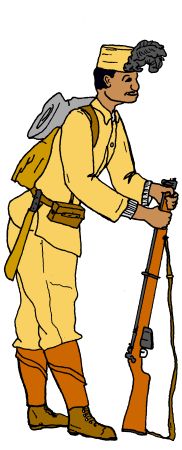 |
 |
 |
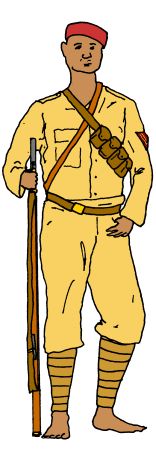 |
 |
|
Figure 1
Askari |
Figure 2
Askari |
Figure 3
Askari NCO |
Figure 4
Askari NCO |
Figure 5
Askari |
Uniforms of the German East African
Schutztruppe Askaris
1914-18
The Schutztruppe askaris started the First World
War dressed as they had been since the
mid-1890s (see Schutztruppe Askaris 1896-1914).
Many kept all or some of this uniform for several years. But as the war wore on without fresh supplies of uniforms, the once smart askaris
became less and less uniformly dressed. New uniforms and equipment came from
captured and improvised stocks which were often dyed a shade of
khaki with the root
of the Ndaa tree. Later in the war fewer askaris were
seen wearing the original issue uniform and tarbush (and when the tarbush was
worn it was often with the eagle removed). Most units wore a
variety of non-regulation clothing and uniforms, slouch hats and fezzes, German
or allied field caps and even woolly hats.
The following first
hand description of three askaris in 1917 is taken from "Blockade and Jungle" by
Christen P Christensen (See Book Reviews Page) and is typical of askaris from the later war period-
"I had a look at our reinforcements...they were
three askaris. The man on one side of me had on an ordinary felt hat, and
something that had once been a shirt, but it was so tattered and torn that his
gleaming black skin showed through it in many places. He also had an excellent
pair of trousers, which didn't look as if they were German in origin, and a
good pair of boots on his bare feet. However he was well supplied with
cartridge pouches, and also had two machine gun belts across his chest like
bandoliers. His gun was a long barrelled, small bore Portuguese rifle, which
gave a peculiar sharp, ringing crack. He was a veteran....The second third of
our relieving troops....was a good man too, another veteran. He had still an
askari cap and neck cloth, but not another stitch on him except for trousers
and a well filled cartridge belt. He had an old fashioned '71 rifle, which
made a lot of smoke and gave out a dull roar like a shot gun....The man beside
(him)...had on an English khaki shirt, but otherwise more or less regulation
German uniform, he was shooting briskly and vigorously with an English rifle."
The Illustrations
Figure 1 is based on a
photograph of a Schutztruppe Askari probably taken in late 1914 or
early 1915. He still wears his original uniform, but has removed the eagle from his
tarbush to be replaced with an adornment of feathers. This was quite commonplace
it seems, with some askaris simply having one feather stuck into a fez or slouch
hat and others, often NCOs, making quite elaborate decorations. He wears a
civilian striped shirt under his uniform and has a pair of captured
leather gaiters instead of issue puttees. He is armed with a British Lee Enfield
Rifle, possibly one of the 455 captured at the Battle of Tanga along with over
600,000 rounds of ammunition. Later in the war more captured rifles (the
Portuguese 1904 Mauser-Vergueiro was popular) and even hunting rifles came to be in
common use. Rather than a bayonet he carries a machete at his side.
Figure 2 is based on a
photograph of a Schutztruppe Askari taken in 1915 after a raid on
the Uganda railway. He still clings on to the tatters of his original uniform
which is missing several buttons and torn to shreds in places. His tarbush has
either been replaced by a hat woven from grass or has been covered with grass
tied around it. The askaris frequently decorated their headgear with leaves or
grasses for camouflage. His boots appear to be home made, something at which the
askaris became very adept. Boots were made from scraps of leather, animal hides
or even flexible tree bark.
Figure 3 is based on a
photograph of a Schutztruppe Askari NCO of the 21. Feldkompagnie taken in the latter stages of the
war. The slouch hat and bandolier are typical of late war askaris but certainly
not regulation Schutztruppe issue. The tunic appears to be a
captured Portuguese item with the original arm of service collar patches
removed. When allied uniforms and headgear were worn the insignia was of course
removed. Instead a Schutztruppe askari red on khaki NCO rank chevron has been added to the
left sleeve. As the war dragged on fewer insignia regulations were followed, but
rank chevrons were seen throughout the war. His trousers may be captured or
original issue, his puttees are probably improvised. He wears German 1909
ammunition pouches.
Figure 4 is based on a
photograph of another Schutztruppe Askari NCO taken in the latter stages
of the war. He also has little of his original uniform left and wears a
non-regulation shirt and civilian fez. Later in the war some askaris received
the newer 1909 ammunition pouches but many such as this figure had bandoliers
or captured allied cartridge pouches along with locally made water bottles,
knapsacks and colourful blankets.
Figure 5 is based on a
photograph of a Schutztruppe Askari taken in the latter stages of the
war. Field caps such as this were quite commonly worn by askaris (especially
NCOs) later in the war. They all came from captured stocks, this one is probably
British. Again the original insignia was removed. His tunic may
possibly be original although it looks well worn in the original photograph. The
shorts are probably captured British or South African issue, or may be cut down
from another pair of trousers. He carries 1909 German ammunition pouches, a British Lee Enfield rifle
and what appears to be a Portuguese 1904 bayonet. This method
of carrying the rifle slung lengthways over the shoulder was typical of askaris.
| |

East African Schutztruppe Askaris
on the March c1914-16
Although the soldiers mostly wear standard Schutztruppe
issue uniform, some appear to have non standard items, shorts or
missing puttees. Most notable is the leading NCO with a bold
feather display on his Tarbush.
Photo by Walther Dobbertin,
Bundesarchiv /
Wikimedia
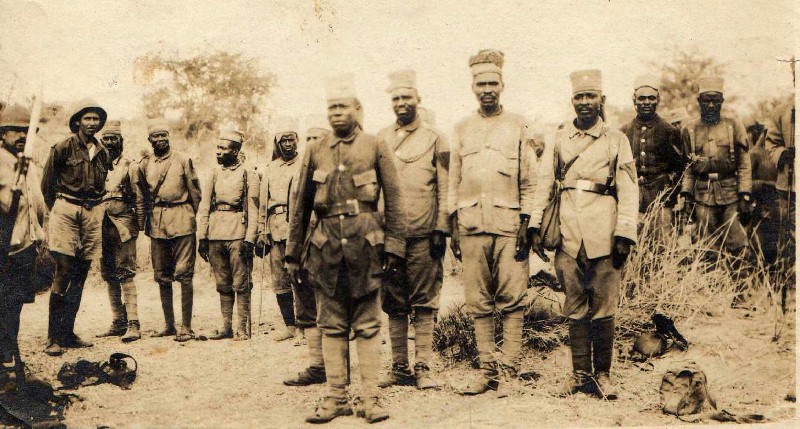
Captured German East African
Schutztruppe Askaris, 1916
This photograph shows German East
African Schutztruppe askaris captured by British Rhodesian troops during the
First World War at Ilembula, December 1916.
In the centre foreground is an
Askari Officer or Effendi. He is distinguished by wearing a pocketed tunic with
turn back cuffs. It is the Schutztruppe 1896 khaki uniform usually worn only by
German officers and NCOs but worn by Effendi without the blue piping or shoulder
straps. This particular tunic seems too big for the wearer. It is possible that
he inherited it from a fallen Effendi when he was promoted. Behind the Effendi are four NCOs
(only three of whom can be clearly seen from this angle). They all wear NCO rank
chevrons in red on the upper left sleeve. The on the right also has
marksmanship award bars on his cuffs. Behind them are the rank and file
askaris. Similar to the NCOs, most still have their original khaki uniforms and
tarbushes although some are in battered shape and none wear the eagle on their
tarbushes anymore. Some wear uniforms with pockets or of a darker shade which
may have been made in the colony or captured. The askaris have been disarmed and
some of their equipment lies scatted on the ground, including ammunition pouches
on the left and knapsacks on the right. They most still wear waist belts with
plain askari belt buckles although the Effendi has an officers open buckle.
The Rhodesian troops on the far left
wear a mixture of British khaki tropical uniform and Wolseley tropical helmets.
As can be seen it would be very hard to tell them from Schutztruppe officers of
the period. The soldier on the edge of the photograph has a Lee Metford or Long
Lee Enfield rifle with its 1888 pattern bayonet.
Photo © Chris Wood
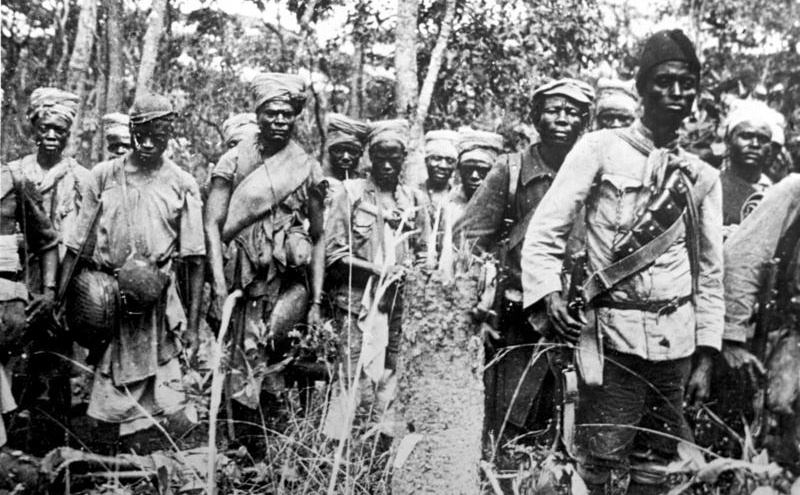
East African Schutztruppe
Porters (on the left) and Askaris (on the right) c1917
At this late stage in the war the
askaris are not wearing Schutztruppe uniform. Note the
non-matching shades and cuts of their uniforms, with different
pocket and collar shapes. The askari in the foreground with a
fez and bandolier is armed with a British Lee Enfield Rifle.
Photo from
Bundesarchiv /
Wikimedia
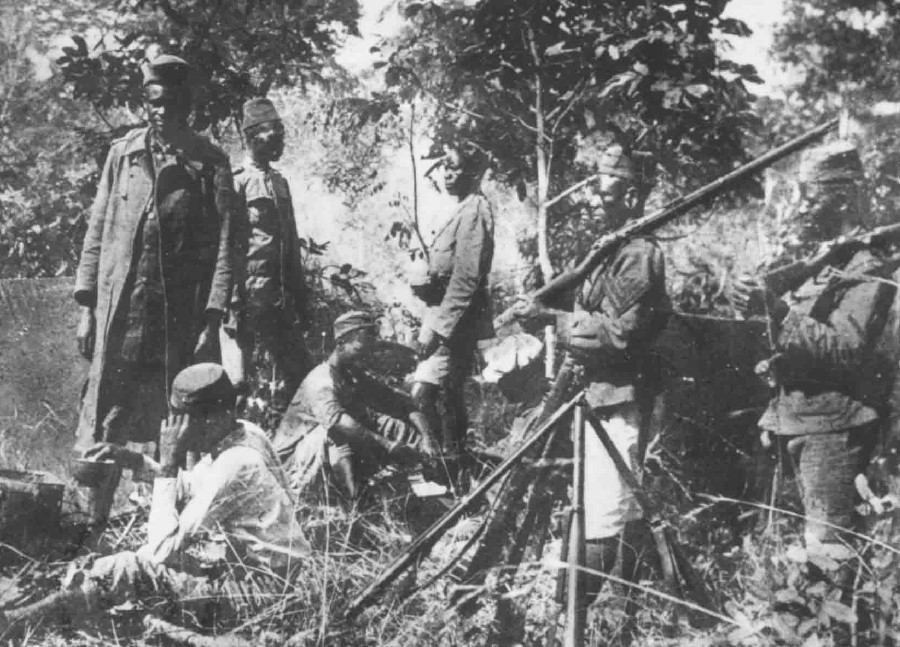
East African Schutztruppe
Askaris in Camp c1917
As with other photos on this page, at this late stage in the war the
askaris are not wearing Schutztruppe uniform. Note the
non-matching shades and cuts of their uniforms. The askari on the
left wears a captured greatcoat. Askaris were not issued greatcoats by
the Schutztruppe. Despite the lack of uniformity the two askaris on the
right with shouldered rifles still have NCO chevrons on their left
sleeves.
Photo ©
Frankfurt University Koloniales Bildarchiv
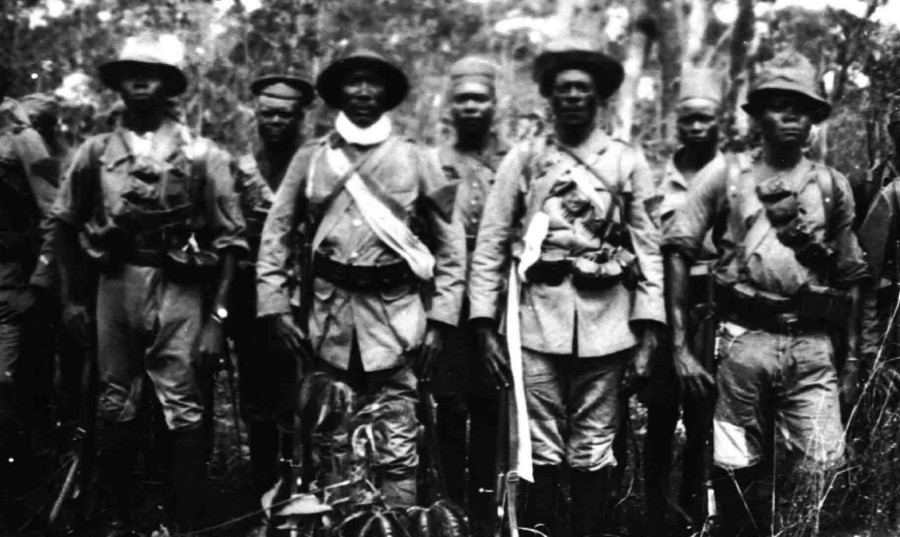
NCOs of the 21. Feldkompagnie c1917
As with other photos on this page, at this late stage in the war the
askaris are not wearing Schutztruppe uniform. Note the
non-matching shades and cuts of their uniforms. They mostly wear
rough slouch hats although one askari in the background has a captured
peaked cap. Note the mixed types of ammunition belts and bandoliers
worn. Again, despite the lack of uniformity the four askaris in the
foreground still have NCO chevrons on their left
sleeves.
Photo by
Wilhelm Erhart ©
Frankfurt University Koloniales Bildarchiv

Askaris of the
21. Feldkompanie c1917
Again there is little if anything of the original
uniforms to be seen and the askaris wear a mixture of captured and
improvised uniforms, equipment and weapons.
Photo by
Wilhelm Erhart ©
Frankfurt University Koloniales Bildarchiv
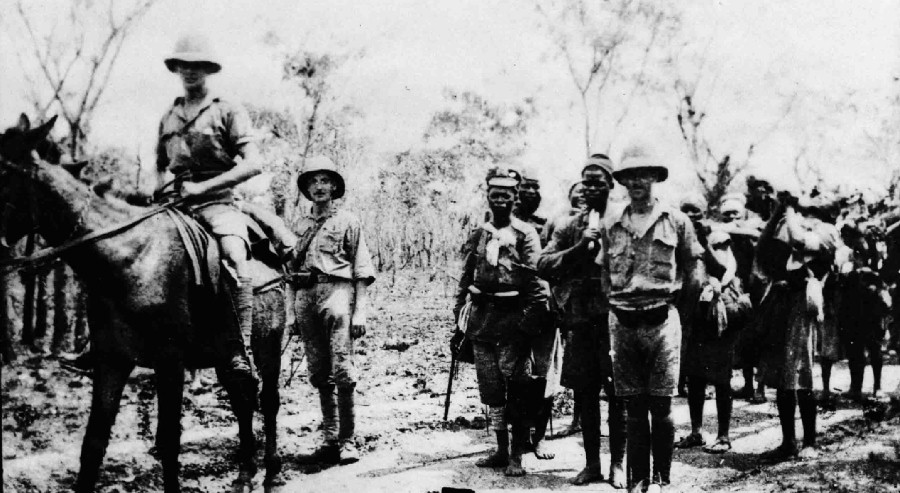
The Second Battery of the East African
Schutztruppe on the March c1918
Oberleutnant
zur See Richard Wenig the commander of the gun captured at Mahiwa (mounted on the left) leading troops of the
Schutztruppe 2 Batterie. Very few Schutztruppe officers were mounted
at this stage in the war. Wenig is mostly likely an exception
because he had lost his left foot in action around the Rufiji in
1916 and wore a handmade prosthetic for the remainder of the war. He
was one of the last German officers to surrender along with von
Lettow-Vorbeck in November 1918.
The
askaris to the right wear a mixture
of Schutztruppe, captured
and improvised uniforms, equipment and weaponry as was common in late
war photographs.
Photo from Wilhelm Erhart
©
Frankfurt University Koloniales Bildarchiv
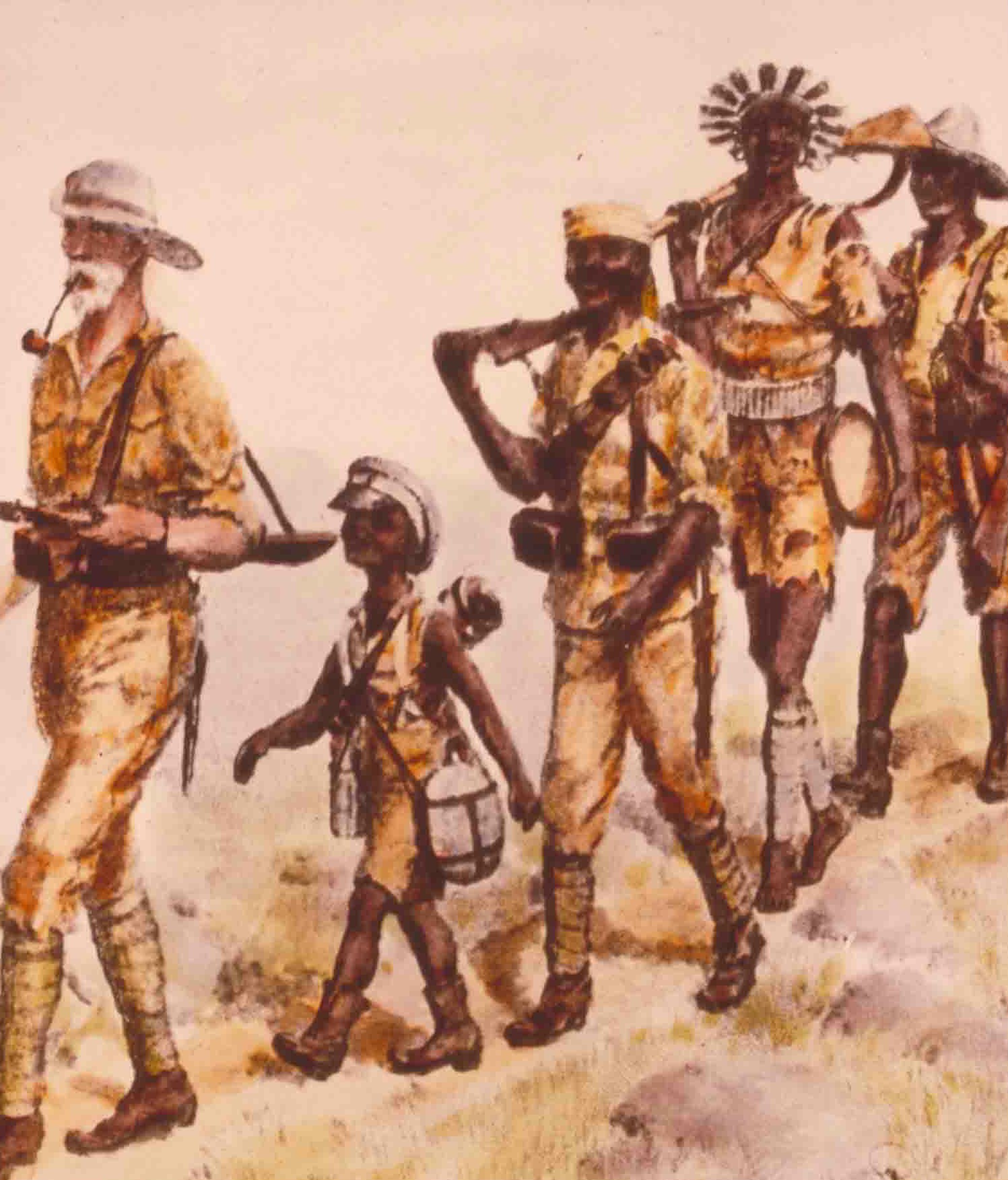 |
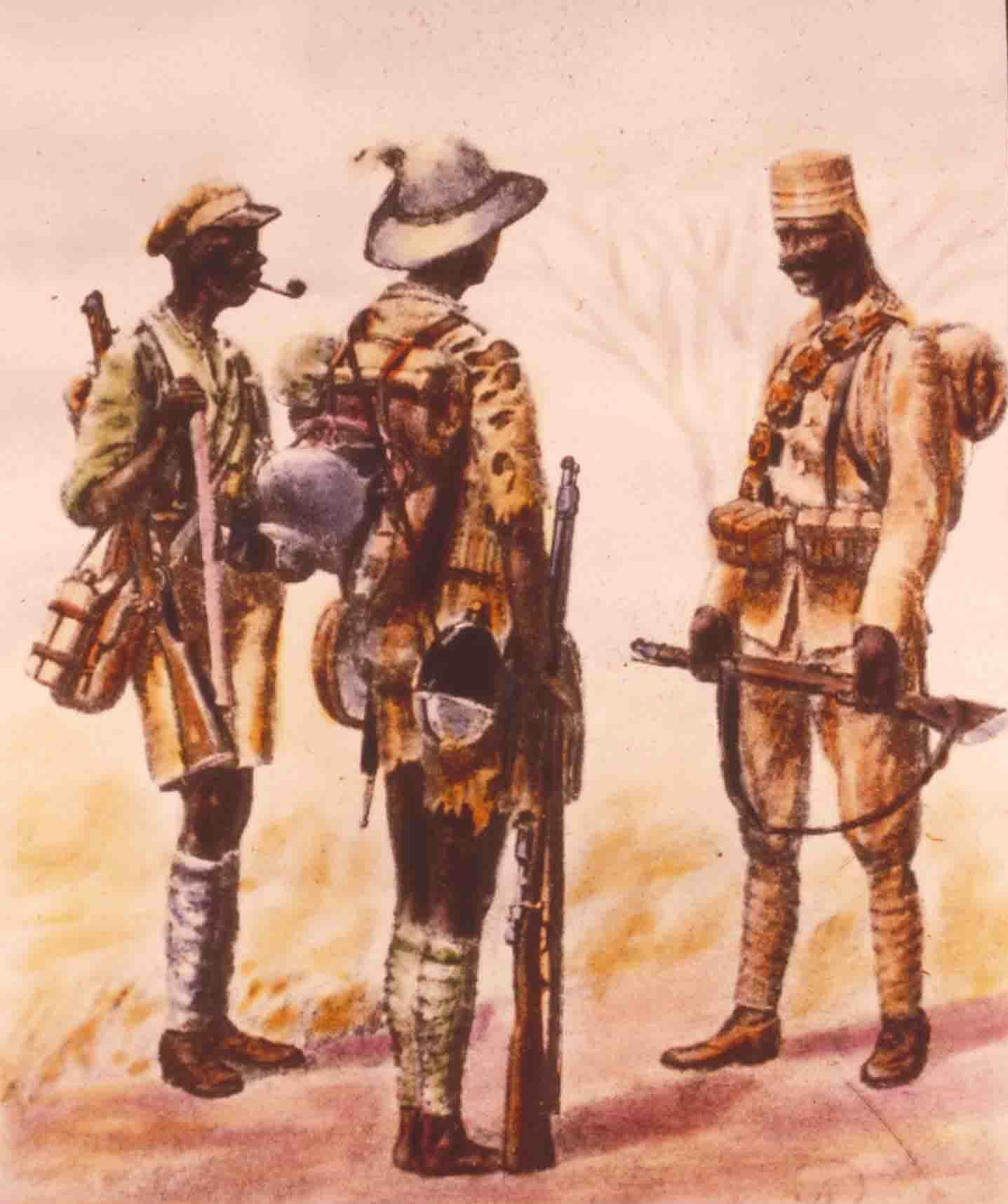 |
East African Askaris
c1916-18
These eyewitness water colour paintings shows East African
Askaris wearing mixtures of Schutztruppe, captured and
improvised uniforms, equipment and weaponry. Their ragged
appearance is brought vividly to life in this series of
watercolours by W Rehfeld published as "Bilder vom
Kriege in Deutsch-Ostafrika". This whole collection can be seen at
the
Reichskolonialamt website.
Illustrations by
W Rehfeld
at
Reichskolonialamt
|
|
|
|













